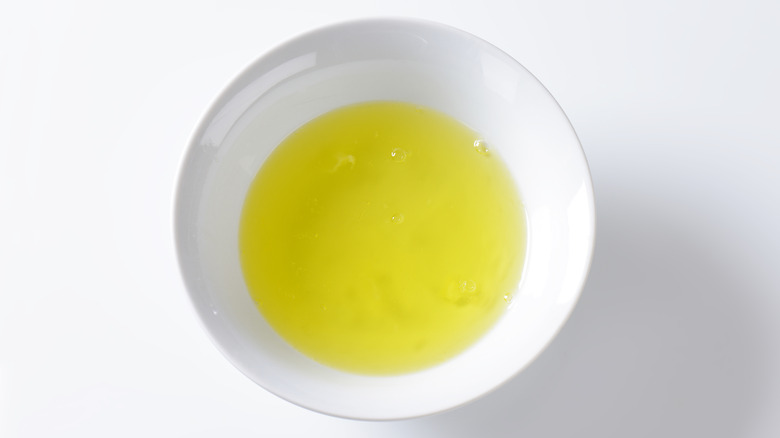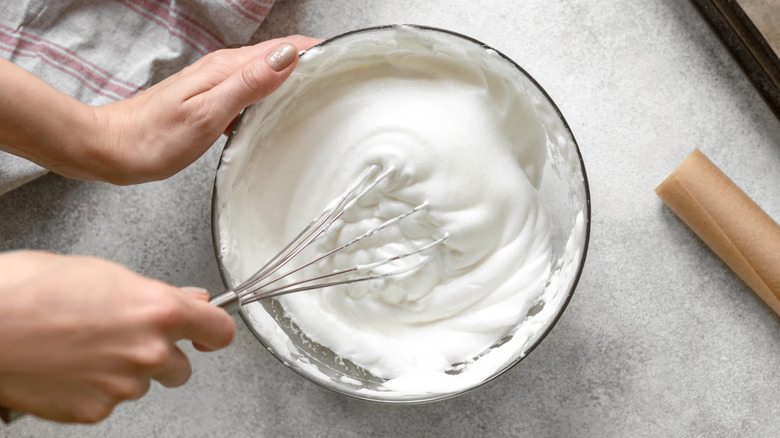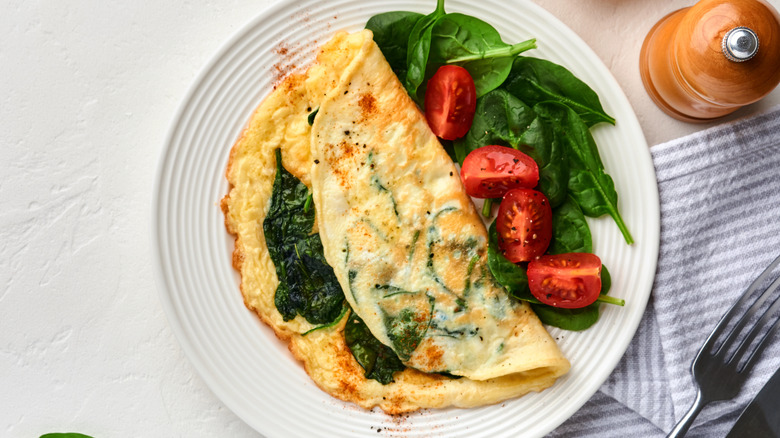What's Actually In Store-Bought Egg White Cartons
If you were to compare fresh egg whites to the ready-to-pour liquid kind sold in cartons, you would notice a big visual differences. The whites from a freshly-cracked egg are more thick and viscous, but the store-bought kind is a lot thinner, almost watery. You may be wondering if these liquid egg whites contain some sneaky extra ingredients that affect the way they look and behave.
In reality, most brands of pre-cracked egg whites sold in a carton or bottle include egg whites and nothing else. You can check the ingredients list or look for products labeled as "100% egg whites" just to be sure, but the thin texture — while odd to those who aren't used to it — doesn't denote any artificial ingredients, or even excessive processing. The whites from a carton just look different because they have to be pasteurized.
This heat-treatment process, which is also sometimes used for whole eggs, decreases the likelihood of harmful bacteria growing in a product that's usually quite susceptible to spoilage. Pasteurization also happens to make the whites thinner in consistency, but doesn't change their flavor or nutritional density. However, while pre-cracked egg whites are great for omelets, high-protein scrambles, and even stir-fries, you can't use them in every recipe that calls for freshly-cracked eggs.
Can you use packaged and fresh egg whites interchangeably?
Separating egg yolks and whites isn't that difficult, if you use some finesse or a handy kitchen tool that easily separates eggs, but nothing beats the convenience of pouring egg whites out of a carton that is ready-to-go in your fridge. However, the pasteurization process causes these products to cook up a bit differently than the fresh stuff. Pourable egg whites cook up less firm and more soft. They might not have the "bite" you expect from a forkful of scrambled eggs or an omelet. They also don't have the same aerating qualities as fresh egg whites.
Packaged egg whites should be avoided in situations where you whip air into them. They won't aerate, expand, and make a stiff foam for classic, frothy egg white cocktails or fanciful cloud eggs. Meringue cookies, homemade Japanese-style pancakes, and angel food cakes are off the table, too. Packaged egg whites can sometimes work when mixed into a batter or dough, but for particularly finicky baking recipes (and most baked goods are finicky), it may be best to skip the carton. You don't want to negatively affect the final product just because you don't feel like cracking eggs.
The best ways to use store-bought egg whites
As long as you don't need to whip them, packaged egg whites are definitely a time-saver for a ton of different dishes. A recipe for something like seasoned, roasted nuts, which only require the egg whites to be whipped until foamy, can definitely work with a carton. Rather than whites beaten into stiff peaks, the glaze on top of candied nuts only needs them to be slightly aerated.
Liquid egg whites are most popularly used to make quick egg scrambles, omelets, and frittatas. To disguise the slightly different texture of pre-cracked eggs, incorporate a combination of vegetables, cheeses, and meats into your dish. You can also serve the cooked egg whites in a sandwich, or pile these easy roasted potatoes with garlic on top of a simple egg white omelet.
These convenient products can even be used as a binder in meatballs, fritters, and veggie burgers. Briefly cook the whites and slice them up, and they can add some bulk to fried rice or stir-fried noodles. You can also cut fresh, whole eggs with egg whites for a fat-free protein boost. Additionally, if you're wary of recipes that use raw eggs, pre-cracked whole eggs are a safer option for recipes like Caesar dressing, tiramisu, and eggnog. The pasteurization process makes it less likely that eggs from a carton will make you sick.



